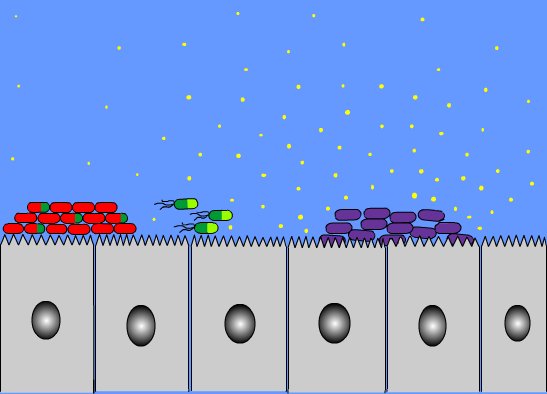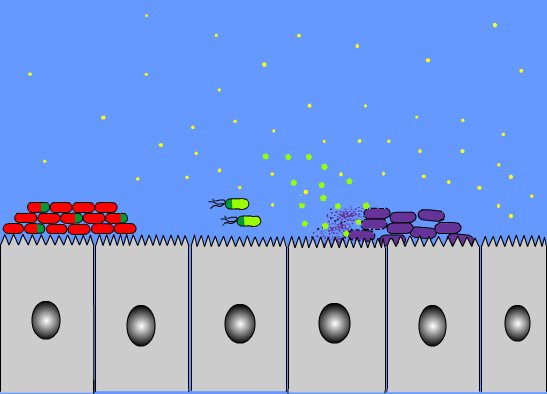Team:USTC-China/Project/futurework
From 2011.igem.org
(→Theoretical Design) |
(→Theoretical Design) |
||
| Line 28: | Line 28: | ||
[[File:j().jpg|center|560px| Figure5.]] | [[File:j().jpg|center|560px| Figure5.]] | ||
<p align=center>Figure5.</p> | <p align=center>Figure5.</p> | ||
| + | <p> In this design, we assume the small molecule is theophylline. So the reprogrammed bacteria will move toward the infection site with a high concentration of theophylline, while the expression of Lysis becomes more and more. As the bacteria stop moving, they will destroy themselves and release the Pyosin, which is expressed at the beginning of the process, to kill the pathogens.</p> | ||
| + | <p> Besides, the Lysis protein can be replaced by ccdB protein, and the Pyosin also can be substituted by other proteins of destruction, and the theophylline also can be replaced by other small molecules or catalyzed from other molecules like caffein or some amino acids.</p> | ||
Revision as of 10:38, 3 October 2011
Contents |
Artificial Innate Immunity System(AIIS)
Background
From mid May to June, enteropathogenic E.coli brings a big panic to many different European countries. Why such an ordinary bacteria as E.coli can lead to a clinical catastrophe and kill a lot of people? The answer may be complicate, but the most important reason is that we can not find out the pathogens rapidly and can not apply the effective treatments.To solve this problem, we try to use the normal E.coli, which keep the symbiotic relationship with us humanbeings, to be a safety weapon to defend ourselves against pathogens.
Figure1.Enteropathogenic Escherichia coli(left) brings us a big panic(right)
Purpose
Using reprogrammed intestinal bacteria as a safety weapon to destroy the pathogens which invade the intestinal mucosal system.
Principle
As shown in Figure2, When pathogens invade the intestinal epithelium ,they will release some kind of chemical signal. After the reprogrammed intestinal bacteria capture this signal, such signal can activate the expression of the function gene ,then it will drive the reprogrammed intestinal bacteria to move toward the infection site from the original colony. Then the moving reprogrammed bacteria will establish a new colony at the infection site, these bacteria will express some lethal proteins to kill pathogens by self-destruction, or spread some toxic small molecules to destroy the pathogens then start self-destruction, and the original colony will remain.
(a)
(b)
Figure2.Reprogrammed intestinal bacteria move towards the target and establish a colony(a),then destroy the taget(b)
Theoretical Design
1.AI(Auto Inducer)as a Chemical Signal
By using the device from the article Engineering microbes to sense and eradicate Pseudomonas aeruginosa, a human pathogen (Figure3.), we can modify our original design to achieve the function which we have described before.(As shown in Figure4.)
Figure3.
Figure4.
In this design, the rhlPR is a RHLR/RHL Inducible Promoter, and we can assume the AI comes from pathogen is RHL. So the reprogrammed bacteria will move toward the the infection site with a high concentration of RHL and stop, then they will decompose and release the pyosin to destroy the pathogens.
2.Other small molecules as chemical signals
By using the device from the article Engineering microbes to sense and eradicate Pseudomonas aeruginosa, a human pathogen (Figure 3.), we can modify our original design to achieve the function which we have described before(Figure 5.).
Figure5.
In this design, we assume the small molecule is theophylline. So the reprogrammed bacteria will move toward the infection site with a high concentration of theophylline, while the expression of Lysis becomes more and more. As the bacteria stop moving, they will destroy themselves and release the Pyosin, which is expressed at the beginning of the process, to kill the pathogens.
Besides, the Lysis protein can be replaced by ccdB protein, and the Pyosin also can be substituted by other proteins of destruction, and the theophylline also can be replaced by other small molecules or catalyzed from other molecules like caffein or some amino acids.
 "
"






